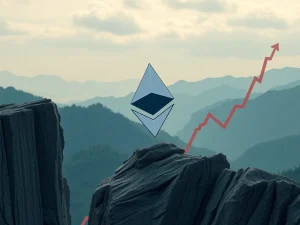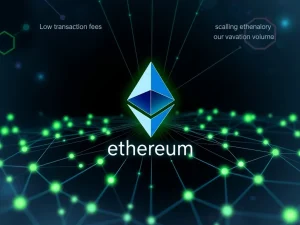Ethereum Stablecoins See Explosive Growth: Unprecedented $165 Billion Marks RWA Dominance

The digital asset landscape is witnessing a significant shift. Ethereum, the leading smart contract platform, recently recorded an astonishing influx of stablecoins. This surge highlights its pivotal role in the burgeoning Real-World Asset (RWA) tokenization market. Last week alone, Ethereum added approximately $5 billion in new stablecoins. This pushed the total supply on the network to an all-time high. This remarkable growth underscores Ethereum’s growing importance for both retail and institutional players.
The Unprecedented Rise of Ethereum Stablecoins
Ethereum’s stablecoin supply has reached a new peak. Data from Token Terminal reveals an all-time high of $165 billion. This figure represents a doubling since January 2024. Furthermore, this impressive growth underscores the network’s increasing utility. Other data providers, like RWA.xyz, report slightly different but equally robust figures. They indicate $158.5 billion in Ethereum-based stablecoins. This also marks an all-time high for the network. Ethereum now commands a substantial 57% market share in the stablecoin sector. This clearly positions it as the undisputed leader.
The influx of these digital assets is not merely a number. It reflects a fundamental shift in how value moves and is stored. Stablecoins offer a bridge between traditional finance and the decentralized world. They provide stability in volatile crypto markets. Consequently, their adoption on Ethereum signals deep trust in the network’s infrastructure. This trust extends to its security and robust ecosystem. The weekly inflow of roughly $1 billion almost every day last week showcases this momentum. This sustained growth is a testament to Ethereum’s appeal for large-scale financial operations.
Ethereum Dominance in the Stablecoin Arena
Ethereum has solidified its position as the network of choice for stablecoins. Its closest competitor, Tron, holds a 27% market share. Solana, while a significant player, lags with less than 4%. This stark contrast illustrates Ethereum’s unparalleled reach and adoption. Several factors contribute to this significant Ethereum dominance. These include:
- Robust Security: Ethereum’s battle-tested security model offers unparalleled reliability.
- Vast Liquidity: The network boasts deep liquidity pools for various stablecoins.
- Developer Ecosystem: A large, active developer community continuously innovates and builds.
- Network Effects: More users and projects attract even more participants, creating a virtuous cycle.
These elements combine to create a compelling environment. They make Ethereum the preferred platform for issuing and transacting stablecoins. As a result, this dominance is likely to strengthen as the market matures. The network’s foundational strengths continue to attract major players.
Expanding Horizons: Tokenized Gold and Other RWAs
Stablecoins are not the only Real-World Assets finding a home on Ethereum. The network has also seen an all-time high in tokenized gold. Currently, approximately $2.4 billion worth of tokenized gold resides on Ethereum. This figure has doubled year-to-date. Tokenized gold offers several advantages. Investors can enjoy fractional ownership and enhanced liquidity. It also provides 24/7 trading access. These benefits appeal to a broad range of investors.
RWA.xyz reports that Ethereum holds a commanding 77% market dominance for tokenized commodities. When including the layer-2 Polygon network, this share climbs even higher to 97%. This demonstrates Ethereum’s ecosystem-wide strength. Beyond gold, Ethereum also secures more than 70% market share of tokenized US Treasurys. These are the second largest asset class to move onto the blockchain, after private credit. This diverse tokenization highlights the network’s versatility. It also proves its capability to handle a wide array of traditional financial instruments.
The Power of RWA Tokenization: Driving Value
The narrative surrounding RWA tokenization has significantly impacted Ether (ETH) prices. ETH surged over 200% since April. It reached an all-time high just below $5,000 on August 24. This price action reflects investor confidence in Ethereum’s long-term potential. Furthermore, treasury corporations have rapidly accumulated Ether. They scooped up almost 4% of the entire supply in just five months. This accumulation by large entities underscores a growing belief. They see Ethereum as a foundational layer for future finance.
Ethereum educator Anthony Sassano points to “credible neutrality” as a key driver. This fundamental principle is central to Ethereum’s design. Sassano explains, “The only way mass adoption of this technology happens is through actual, credibly neutral, and permissionless systems that are not owned by anyone and are not affiliated with any single entity.” This philosophy ensures fairness and transparency. It also builds trust among diverse participants. Credible neutrality is therefore vital for attracting traditional institutions. They seek secure, unbiased platforms for their assets.
Institutional Adoption and the Future of Finance
Global financial institutions are increasingly exploring blockchain technology. Many are choosing Ethereum for their tokenization initiatives. Fidelity, the world’s third-largest asset manager, recently launched a tokenized US Treasurys fund on Ethereum. Sassano highlighted this significant development. The Fidelity Digital Interest Token (FDIT) appears to have launched on-chain on September 1. It currently holds $203.6 million in total asset value, according to RWA.xyz. This move by a major player like Fidelity signals a profound shift. It validates the potential of blockchain technology in mainstream finance.
The growing trend of institutional adoption is transformative. It bridges the gap between traditional financial systems and decentralized networks. This integration brings unprecedented levels of liquidity and efficiency. It also opens new investment avenues. As more institutions follow Fidelity’s lead, Ethereum’s role will only expand. The network is becoming a cornerstone for a new era of finance. This era is characterized by transparency, efficiency, and global accessibility. The future of RWA tokenization looks bright on Ethereum.
The continuous growth of Ethereum stablecoins and RWA tokenization solidifies Ethereum’s position. It is clearly a leading force in the digital asset space. Its robust infrastructure, credible neutrality, and growing institutional backing create a powerful combination. This positions Ethereum for sustained growth and innovation. The network is not just processing transactions. It is actively reshaping the global financial landscape. Its influence continues to expand, promising an exciting future for tokenized assets.










